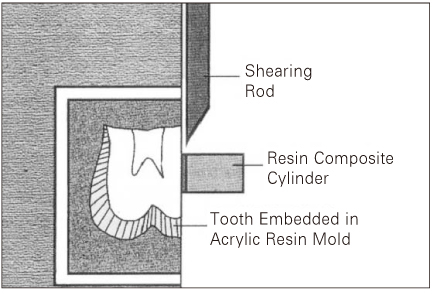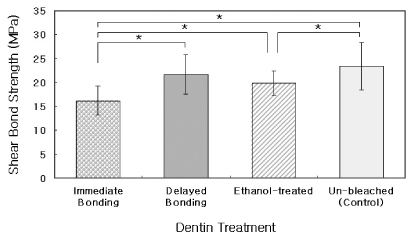J Korean Acad Conserv Dent.
2006 Mar;31(2):79-85. 10.5395/JKACD.2006.31.2.079.
Effect of vital tooth bleaching agent on dentin bonding
- Affiliations
-
- 1Department of Conservative Dentistry, School of Dentistry, Kyungpook National University, Korea. skykim@knu.ac.kr
- KMID: 1986852
- DOI: http://doi.org/10.5395/JKACD.2006.31.2.079
Abstract
- To evaluate the effect of vital tooth bleaching agent and alcohol pretreatment on dentin bonding, flat dentin windows were produced on the buccal side of the crowns of fifty-five extracted, human premolars. A bleaching gel, Opalescence(R) with 10% of carbamide peroxide (Ultradent Product, USA) was daily applied on the teeth of three experimental groups for six hours for 10 consecutive days, while teeth of a control group were not bleached. After 6 hours of bleaching gel application, the specimens were washed and stored in saline until the next day application. After application of One-step(R) dentin bonding agent (Bisco, USA), Z-250(R) resin (3M-ESPE, USA) was bonded to dentin with a mount jig. Shear bond strength was measured with an Instron machine (Type 4202, Instron Corp., USA) after 24 hours. The results were analyzed using one-way ANOVA and Duncan's multiple range test at p < 0.05. Immediate bonding group showed significantly lower bond strength than un-bleached control group (p < 0.05). Ethanol-treated group showed significantly higher bond strength compared to immediate bonding group (p < 0.05). However, the bond strength of the ethanol treatment group was lower than that of the un-bleached control group (p < 0.05). There were no significant difference in shear bond strength between the 2-week delayed bonding group and the ethanol-treated group (p > 0.05) and between delayed bonding group and un-bleached control group (p > 0.05). In the condition of the present study, it seems that alcohol pretreatment after bleaching procedure can reduce the adverse effect of vital bleaching agent on dentin bonding.
Figure
Reference
-
1. Wandera A, Feigal RJ, Douglas WH, Pintado MR. Home-use tooth bleaching agents: an in vitro study on quantitative effects on enamel, dentin, and cementum. Quintessence Int. 1994. 25:541–546.2. Covington JS, Friend GW, Lamoreaux WJ, Perry T. Carbamide peroxide tooth bleaching: effect on enamel conposition and topography. J Dent Res Special Issue. 1990. 530.3. Haywood VB, Heymann HO. Nightguard vital bleaching. Quintessence Int. 1989. 20(3):173–176.4. García-Godoy F, Dodge WW, Donohue M, O'Quinn JA. Composite resin bond strength after enamel bleaching. Oper Dent. 1993. 18:144–147.5. Torneck CD, Titley KC, Smith DC, Adibfar A. The influence of time of hydrogen peroxide exposure on the adhesion of composite resin to bleached bovine enamel. J Endod. 1990. 16:123–128.
Article6. Titley KC, Torneck CD, Ruse ND, Krmec D. Adhesion of a resin composite to bleached and unbleached human enamel. J Endod. 1993. 19:112–115.
Article7. Torneck CD, Titley KC, Smith DC, Adibfar A. Adhesion of light-cured composite resin to bleached and unbleached bovine dentin. Endod Dent Traumatol. 1990. 6:97–103.
Article8. Kaya AD, Turkun M. Reversal of dentin bonding to bleached teeth. Oper Dent. 2003. 28:825–829.9. Buettner GR. The pecking order of free radicals and antioxidants: lipid peroxidation, alpha-tocopherol, and ascorbate. Arch Biochem Biophys. 1993. 300:535–543.
Article10. Titley KC, Torneck CD, Ruse ND. The effect of carbamide-peroxide gel on the shear bond strength of a microfil resin to bovine enamel. J Dent Res. 1992. 71:20–24.
Article11. Spyrides GM, Perdigao J, Pagani C, Araujo MA, Spyrides SM. Effect of whitening agents on dentin bonding. J Esthet Dent. 2000. 12:264–270.
Article12. Kum KY, Han YS, Jung IY, Lee SJ, Lee CY, Oh BH. A quantitative study on the degrading effect of the various cavity irrigating agents in the elimination of residual hydrogen peroxide following walking bleaching. J Korean Acad Conserv Dent. 1998. 23(2):656–669.13. Sung EC, Chan SM, Mito R, Caputo AA. Effect of carbamide peroxide bleaching on the shear bond strength of composite to dental bonding agent enhanced enamel. J Prosthet Dent. 1999. 82:595–599.
Article14. Gökay O, Mujdeci A, Algin E. Peroxide penetration into the pulp from whitening strips. J Endod. 2004. 30:887–889.
Article15. Kwon YH, Huo MS, Kim KH, Kim SK, Kim YJ. Effects of hydrogen peroxide on the light reflectance and morphology of bovine enamel. J Oral Rehabil. 2002. 29:473–477.
Article16. Goldstein GR, Kiremidjian-Schumacher L. Bleaching: is it safe and effective? J Prosthet Dent. 1993. 69:325–328.
Article17. Leonard RH Jr, Bentley CD, Haywood VB. Salivary pH changes during 10% carbamide peroxide bleaching. Quintessence Int. 1994. 25:547–550.18. Shinohara MS, Rodrigues JA, Pimenta LA. In vitro microleakage of composite restorations after nonvital bleaching. Quintessence Int. 2001. 32:413–417.19. Türkün M, Turkun LS. Effect of nonvital bleaching with 10% carbamide peroxide on sealing ability of resin composite restorations. Int Endod J. 2004. 37:52–60.
Article20. Titley KC, Torneck CD, Smith DC, Chernecky R, Adibfar A. Scanning electron microscopy observations on the penetration and structure of resin tags in bleached and unbleached bovine enamel. J Endod. 1991. 17:72–75.
Article21. Lai SC, Mak YF, Cheung GS, Osorio R, Toledano M, Carvalho RM, Tay FR, Pashley DH. Reversal of compromised bonding to oxidized etched dentin. J Dent Res. 2001. 80:1919–1924.
Article22. Lai SC, Tay FR, Cheung GS, Mak YF, Carvalho RM, Wei SH, Toledano M, Osorio R, Pashley DH. Reversal of compromised bonding in bleached enamel. J Dent Res. 2002. 81:477–481.
Article23. Kum KY, Lim KR, Lee CY, Park KH, Safavi KE, Fouad AF, Spangberg LS. Effects of removing residual peroxide and other oxygen radicals on the shear bond strength and failure modes at resin-tooth interface after tooth bleaching. Am J Dent. 2004. 17:267–270.24. Kim KK, Park JW. Comparison of shear bond strength of different bonding systems on bleached enamel. J Korean Acad Conserv Dent. 2004. 29:30–35.
Article25. Cvitko E, Denehy GE, Swift EJ, Pires KA. Bond strength of composite resin to enamel bleached with carbamide peroxide. J Esthet Dent. 1991. 3:100–102.
Article26. Kalili KT, Caputo AA, Yoshida K. Effect of alcohol pretreatment on composite bond strength to bleached enamel. J Dent Res. 1993. 72:283.27. Rotstein I, Wesselink PR, Bab I. Catalase protection against hydrogen peroxide-induced injury in rat oral mucosa. Oral Surg Oral Med Oral Pathol. 1993. 75:744–750.
Article28. Rotstein I. Role of catalase in the elimination of residual hydrogen peroxide following tooth bleaching. J Endod. 1993. 19:567–569.
Article
- Full Text Links
- Actions
-
Cited
- CITED
-
- Close
- Share
- Similar articles
-
- Effect of post-bleaching time intervals on resin in dentin bonding strength
- The effects of dentin bonding agent thickness on stress distribution of composite-tooth interface : Finite element method
- The comparison of microtensile bond strength with immediate and delayed dentin sealing
- The effects of desensitizing agents, bonding resin and tooth brushing on dentin permeability, in vitro
- The comparison of microleakage on intracoronal restoration after non-vital bleaching



